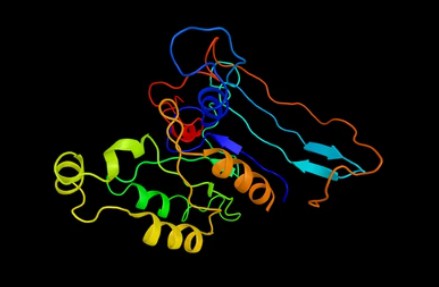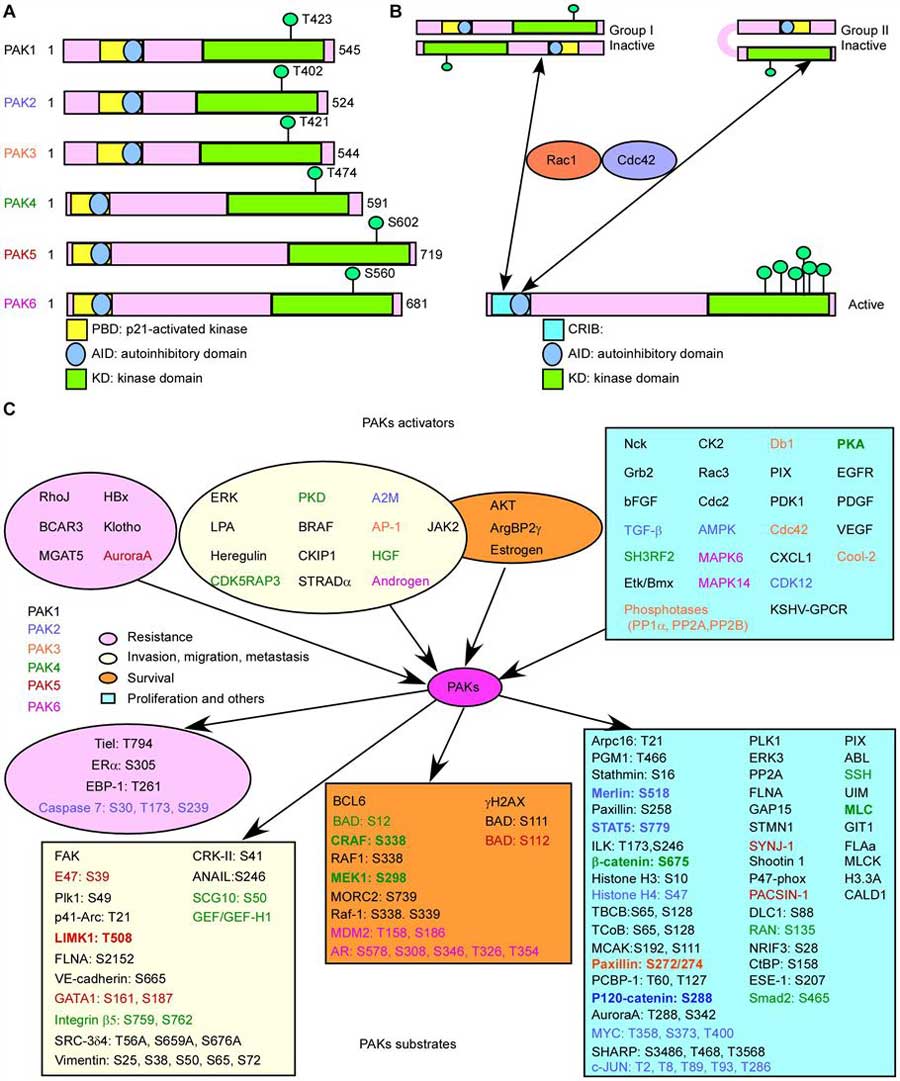PAK (p21-activated Kinases)
About PAK (p21-activated Kinases)
PAK (p21-activated Kinases) are a class of Ser/Thr kinases, belonging to the mitogen-activated protein kinase (MAPK) family. PAKs play central roles in a wide range of cellular processes including regulation of PAKs play central roles in a wide range of cellular processes including regulation of proliferation, cell motility, morphology, and cytoskeletal dynamics, and are expressed in a wide variety of tissues.
PAKs were originally identified as effectors for the GTPases, cell division control protein 42 (CDC42), and RAC (Ras-related C3 botulinum toxin substrate), but a number of them have been identified in a variety of tissues. substrate), but some GTPase-independent pathways have also been reported that are regulated by this family of kinases. PAK kinases regulate cell signaling and cellular signaling mainly by interacting with small GTPase molecules to regulate cell signaling and cytoskeleton dynamics. They are widely expressed in a variety of cell types, including immune cells, neuronal cells, muscle cells, and epithelial cells.
There are six members in the PAKs family, which are divided into two groups based on the sequence and structure homology: group I PAKs (including PAK1, PAK2, and PAK3) and group II PAKs (including PAK4, PAK5, and PAK6). Genetic and knockdown experiments in frogs, fish, and mice indicate group I PAKs are widely expressed, required for multiple tissue development, and particularly important for immune and nervous system function in the adult. The group II PAKs (human PAKs 4-6) are more enigmatic, but their restriction to metazoans and presence at cell-cell junctions suggests these kinases emerged to regulate junctional signaling. Studies of protozoa and fungal PAKs show that they regulate cell shape and polarity through the phosphorylation of multiple cytoskeletal proteins, including microtubule-binding proteins, myosins, and septins.
Activation of PAK kinases is usually regulated by extracellular stimuli such as cytokines, growth factors, and environmental stimuli. Once activated, PAK kinase can regulate multiple cellular processes by phosphorylating substrate proteins.

Mechanism of Action of PAK (p21-activated Kinases)
All PAKs contain a carboxyl-terminal kinase domain (KD), a p21-binding domain (PBD), and an auto-inhibitory domain (AID). However, the regulatory domains of PAKs are structurally different, as well as the activation processes.
- The PBDs of group I PAKs overlap with the AIDs. Group I PAK activity is stimulated by binding to the activated small GTPase or some other proteins in the PBD, and concomitant interaction with the proximal amino acids and phosphoinositide, leading to dissociation of the AID from the KD. These changes will induce further conformational changes in the dimerized PAKs and cause activation of their kinase activity.
There are a lot of PAK activators, and downstream substrates have been identified. When bound to the substrate, the KD of PAKs becomes a monomer, and automatically phosphorylation stabilizes PAKs in the activated form, while the overlapping of PBD and AID binds to KD of another PAK and forms inactive homo-dimerization. PAK1 is activated in both GTPase-dependent and GTPase-independent manner via integrating multiple cell membrane receptor signals and proximal cytoplasmic signaling components.
Due to the sequence similarities of group I PAKs, PAK1, PAK2, and PAK3 may share some mechanisms. Group I PAK inactivation is controlled by protein phosphatases, such as PP2A, POPX1, POPX2, PKA, PP1α, and RhoV, as well as microRNA 7 and Merlin. - The structure of group II PAKs is different from that of group I PAKs, which contains an AID-like pseudosubstrate sequence that inactivates the Cdc42-bound PBD kinase activity. There is a lack of understanding of the activity controlling group II PAKs. A potential model proposed that group II PAKs function as a monomer rather than a dimer. The AID binds to KD in cis, which maintains the group II PAKs in an inactive form. It is reported that PAK4 can be activated by HGF independent of PI3K, modulating cytoskeleton organization and cell adhesion. We need more evidence to uncover the group II PAK activity regulation due to the limited results.
 Fig.2 Basic characteristic of p21-activated kinases (PAKs). (A) The structures of PAKs. (B) The activation of PAKs. (C) The upstream activators and downstream effectors of PAKs with related functions. (Liu H, et al., 2021)
Fig.2 Basic characteristic of p21-activated kinases (PAKs). (A) The structures of PAKs. (B) The activation of PAKs. (C) The upstream activators and downstream effectors of PAKs with related functions. (Liu H, et al., 2021)
Functions of PAK (p21-activated Kinases)
PAK (p21-activated Kinases) is an important family of signaling protein kinases involved in the regulation of a variety of cellular processes and biological functions. The following are the main functions of PAK:
- Cytoskeleton Regulation
PAK kinase affects cell morphology, motility, and adhesion by regulating the dynamic reorganization of the cytoskeleton. It phosphorylates and regulates actin, microtubule-associated proteins, intermediate filament proteins, and others, which are involved in cell contraction, extension, morphological changes, and organizational remodeling of the cytoskeleton.
- Cell Migration and Invasion
PAK kinase can promote cellular migratory and invasive properties by regulating cytoskeletal dynamics and the phosphorylation status of cell adhesion-associated proteins. This is important for processes such as embryonic development, tumor metastasis, and inflammatory cell migration.
- Cell Proliferation and Differentiation
PAK kinase regulates the activity of cell cycle regulatory proteins, transcription factors, and cell growth factors, and influences the rate of cell proliferation and differentiation status. In development and tissue formation, PAK function is critical for cell differentiation and morphogenesis.
- Apoptosis
PAK kinases can regulate cell survival and death decisions through cross-talk with apoptotic signaling pathways. In some cases, activation of PAK can promote apoptosis, while in others it can inhibit it.
- Neuromodulation
PAK kinases are involved in the regulation of neuronal growth cone elongation, synapse formation, and synaptic plasticity, and are essential for the development and functional maintenance of neuronal cells.
- Immunomodulation
PAK kinase plays an important role in immune cells such as lymphocytes, macrophages, and dendritic cells. It is involved in the regulation of immune cell migration, phagocytosis, cell polarity, and signaling, and plays a regulatory role in immune response and inflammatory response.
PAK kinases play important functional and regulatory roles in several cellular processes such as cytoskeleton regulation, cell migration, cell proliferation and differentiation, apoptosis, neuromodulation, and immunomodulation. Abnormal regulation of these functions is closely related to the onset and development of a variety of diseases, and thus PAK kinases are regarded as potential therapeutic targets.
Available Resources for PAK (p21-activated Kinases)
Due to their important biological functions, PAKs have become a hot spot for research. Scientists have gained insight into the function and mechanism of action of PAKs by studying their regulatory mechanisms, substrates, and subcellular localization, etc. PAKs also have potential applications in research in the fields of oncology, neurobiology, and immunology, which can provide new drug targets for the treatment of related diseases. Creative BioMart offers a variety of PAK (p21-activated Kinases)-related research products, such as recombinant proteins, cell and tissue lysates, and protein pre-coupled magnetic beads, as well as customizable services and other resources to support your research in the field of PAK. The following PAKs are displayed, click to view all related molecules/targets and research reagents. For further information or to purchase products, please contact us. We are committed to providing the highest quality resources and support for your research to help you succeed.
References:
- Rane C K, Minden A. P21 activated kinases: structure, regulation, and functions[J]. Small GTPases, 2014, 5(1): e28003.
- Liu H, Liu K, Dong Z. The role of p21-activated kinases in cancer and beyond: where are we heading?[J]. Frontiers in cell and developmental biology, 2021, 9: 641381.


